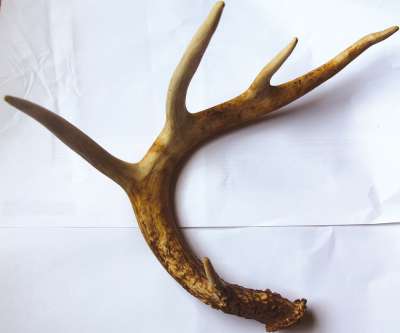A buck grows a new set of antlers every year. The antlers begin growing in mid-March or early April – as they grow they’re covered in velvet and sensitive to touch. In early autumn, rising testosterone levels, triggered by shortening day-length, cause the antlers to harden. Following the breeding season, falling testosterone levels trigger antler casting, which typically happens in late December through February. Early casting is a sign of stress and poor health; late casting is a sign of vigor.
Antler bone is lined with periosteum – think of this tissue like the cambium layer in a tree. The knobby pearlations at the base of the antler form when the periosteum merges with the connective tissue and skin on the outside of the antler. Bucks use these pearlations to shred the bark of the trees they rub. The channels etched on the antler’s surface show where the bone was molded by arteries in the velvet.
The knob on the base of the antler, where it was attached to the pedicle on the skull, provides insight into the deer’s health. If it’s rounded and convex, the buck was healthy. If it’s irregular or concave, it’s a sign the deer was injured or in otherwise poor health.
Antler color is dictated, at least in part, by the velvet-shedding process. As the buck rubs his antlers to remove the velvet, the blood stains the bone. There’s some speculation, as well, that the type of trees in an area can have an effect – rubbing and smearing an antler with softwood pitch may cause darker staining than hardwood sap. Of course, the color of a shed is also dictated by exposure to the sun, which bleaches it, and exposure to the leaf litter, which stains it.
Can you tell a deer’s age by the size of the shed? Not with precision. Lindsay Thomas Jr., Director of Communication at the Quality Deer Management Association, analyzed antler base circumference data, collected by New Hampshire Fish and Game, on more than 5,000 whitetails that were harvested between 2007 and 2016. The idea was that this data set might provide a correlation between girth and age. While the average circumference of the antler grew with age, as you’d expect, the overlap was substantial. The entire range of measurements for yearlings went from 1 to 3.7 inches; the entire range for bucks 5.5 years old and up went from 2.6 to 5.7 inches. In other words, a deer with a 3-inch antler base could potentially be any age but a fawn. The biggest antlers in the New Hampshire collection (5.7 inches) were not the oldest – some of these king bucks were estimated to be only 3.5 years old.
Large anglers can be scored, which gives you an idea of how the deer stacks up to the largest deer in your state. Scoring involves measuring the length of the beam, the length of each point, the circumference in four spots, and the spread. This particular antler scored 59 points; assuming a matched pair and a 20” spread, the rack would have scored 138 inches. A nice Vermont buck, for sure, but the record in the state is 181 inches.
The Resilient Forest Series, Part 2
For generations, white-tailed deer have held a deep and complicated place in our northern culture. From a traditional deer camp in the Adirondacks to how to read a shed antler: a pastiche.
- How Many Deer is Too Many?
- Deer on the Northern Edge
- Deer Camp: A Photo Essay
- A Close Look at an Antler
- A Deer Story, Retold
Our special thanks go to the Emily Landecker Foundation, the Dorr Foundation, the Davis Conservation Foundation, the Larsen Fund, Melinda Richmond, and the Samuel P. Hunt Foundation for their support of this work.


